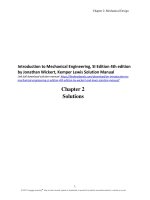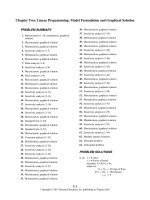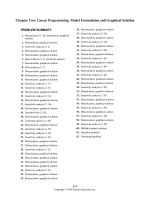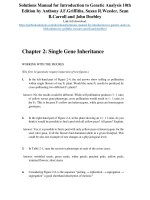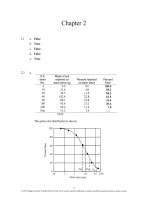Introduction to mechanical engineering SI edition 4th edition by wickert lewis solution manual
Bạn đang xem bản rút gọn của tài liệu. Xem và tải ngay bản đầy đủ của tài liệu tại đây (5.02 MB, 49 trang )
Chapter 2: Mechanical Design
Introduction to Mechanical Engineering, SI Edition 4th edition
by Jonathan Wickert, Kemper Lewis Solution Manual
Link full download solution manual: />
Chapter 2
Solutions
1
© 2017 Cengage Learning®. May not be scanned, copied or duplicated, or posted to a publicly accessible website, in whole or in part.
Chapter 2: Mechanical Design
P2.1: Give three examples of engineered products that must be circular in shape and
explain why. Any ball is not allowed as an answer!
Examples include:
⋅ DVD’s
⋅ CD’s
⋅ manhole covers
⋅ railroad advance warning signs
⋅ wheel (for flat roads)
⋅ axles
⋅ bullet cross-section (balanced for stable flight)
⋅ European speed limit sign
⋅ any shape with minimized arc length/surface area for given area/volume
⋅ optimized pressure vessel cross sections
⋅ US coin
⋅ lens (part of circle)
⋅ optimal nozzle/diffuser (no edge effects)
⋅ optimal capillary tube
⋅ optimal suction cup
⋅ traffic circle
⋅ thrown pot (on potting wheel)
2
© 2017 Cengage Learning®. May not be scanned, copied or duplicated, or posted to a publicly accessible website, in whole or in part.
Chapter 2: Mechanical Design
P2.2: Give three examples of engineered products that must be triangular in shape and
explain why.
Examples include:
⋅ yield signs
⋅ the triangle instrument
⋅ billiards rack
⋅ knife blade (cross-section)
⋅ supports for finishing wood (pyramids or cones, must come to a point)
⋅ splitting wedge
⋅ handicap ramp viewed from side (to meet code)
⋅ three equally spaced instances per rotation cam
⋅ 30°-60°-90° or 45°-45°-90° drafting triangle
⋅ one of six identical pieces that can be assembled into a hexagon
⋅ chisel point
3
© 2017 Cengage Learning®. May not be scanned, copied or duplicated, or posted to a publicly accessible website, in whole or in part.
Chapter 2: Mechanical Design
P2.3: Give three examples of engineered products that must be rectangular in shape and
explain why.
Examples include:
⋅ A size (or any other standard size) sheet of paper
⋅ Four equally spaced instances per rotation cam
⋅ Football/soccer field (civil engineered)
⋅ US speed limit sign
⋅ US dollar bill
4
© 2017 Cengage Learning®. May not be scanned, copied or duplicated, or posted to a publicly accessible website, in whole or in part.
Chapter 2: Mechanical Design
P2.4: Give three examples of engineered products that must be green in color.
Examples include:
⋅ Fake plant/turf (imitate actual plant)
⋅ John Deere product (branding)
⋅ Cameron Compressor (branding)
⋅ Green (traffic) light
⋅ European recycling bin
⋅ Kermit the frog paraphernalia (branding)
5
© 2017 Cengage Learning®. May not be scanned, copied or duplicated, or posted to a publicly accessible website, in whole or in part.
Chapter 2: Mechanical Design
P2.5: Give three examples of engineered products that must be black in color.
Examples include:
⋅ background for one way signs and night speed limit signs
⋅ theater bins/supports (disappears in dark)
⋅ stealth fighter (better “bounce” characteristics)
⋅ ninja suit (stealth at night)
⋅ black paint
⋅ black ink
⋅ backing for solar water heating
6
© 2017 Cengage Learning®. May not be scanned, copied or duplicated, or posted to a publicly accessible website, in whole or in part.
Chapter 2: Mechanical Design
P2.6: Give three examples of engineered products that must be transparent.
Examples include:
⋅ contact lenses (over pupil portion)
⋅ glasses (spectacles)
⋅ (camera) lens (any tint causes loss of quality/information)
⋅ microscope slide and slide cover
7
© 2017 Cengage Learning®. May not be scanned, copied or duplicated, or posted to a publicly accessible website, in whole or in part.
Chapter 2: Mechanical Design
P2.7: Give three examples of engineered products that have a specific minimum weight but
no specified maximum weight, and specify the approximate minimum weight.
Examples include:
⋅ helium balloon holder (minimum weight will depend upon how many helium
balloons are being held)
⋅ non-wedge based door stop (minimum weight based on friction coefficient)
⋅ racecar (minimum weight based on racing regulations)
⋅ competition bike (minimum weight based on racing regulations)
8
© 2017 Cengage Learning®. May not be scanned, copied or duplicated, or posted to a publicly accessible website, in whole or in part.
Chapter 2: Mechanical Design
P2.8: Give three examples of engineered products that have to be precisely a certain
weight, and provide the weight.
Examples include:
⋅ balancing weight for car wheel
⋅ coins (weight used to count coins in some automated machines)
⋅ precious metal coins (weight dictates worth)
⋅ exercise weights (1 kg weight must be 1 kg)
9
© 2017 Cengage Learning®. May not be scanned, copied or duplicated, or posted to a publicly accessible website, in whole or in part.
Chapter 2: Mechanical Design
P2.9: Give three examples of engineered products that fulfill their designed purpose by
failing or breaking.
Examples include:
⋅ saw stop mechanism ( />⋅ crumple zone in car
⋅ bumper (foam insert) in car
⋅ bike helmet
⋅ frangible bullets (split up when they hit anything other than flesh) to protect
bystanders
⋅ stress indicating paint has fluorescent dyes capsules that split under known
deflections ( />⋅ some meds are packaged in glass bottles that you break to open
⋅ cover on a “pit trap” breaks when weight is applied
⋅ fire suppression sprinkler detection device (solder connect melts or glass
connection shatters)
10
© 2017 Cengage Learning®. May not be scanned, copied or duplicated, or posted to a publicly accessible website, in whole or in part.
Chapter 2: Mechanical Design
P2.10: Give three examples of engineered products that are designed to work well over a
million times.
Examples include:
⋅ Roads
⋅ Bridges
⋅ Engine components (if each Otto cycle is a “use”)
⋅ Fuses
⋅ Door hinges
⋅ 3-D shutter glasses (the shutters)
11
© 2017 Cengage Learning®. May not be scanned, copied or duplicated, or posted to a publicly accessible website, in whole or in part.
Chapter 2: Mechanical Design
P2.11: List three products that can be used equally well by people with and without visual
impairments, and explain why.
Examples include:
⋅ Silverware
⋅ Chairs
⋅ Drinking Cups
⋅ Headphones
⋅ Bed
⋅ Drawers
⋅ Emergency response necklace (one button, worn around neck to locate)
/>⋅ Sight and sound cross walk guides
⋅ Fire alarm (day to day use, not installation and maintenance)
⋅ Automatic doors (and other motion detectors)
12
© 2017 Cengage Learning®. May not be scanned, copied or duplicated, or posted to a publicly accessible website, in whole or in part.
Chapter 2: Mechanical Design
P2.27: For the magnesium camera body pieces shown, provide an explanation for which
processes you think were used in its manufacture and why.
This was most likely manufactured using a die cast procedure because of the material and
geometric detail in the pieces including a number of inclusions. Certain features could have
been machined, and some polishing/grinding operations may have been used.
13
© 2017 Cengage Learning®. May not be scanned, copied or duplicated, or posted to a publicly accessible website, in whole or in part.
Chapter 2: Mechanical Design
P2.28: For the aluminum structural member shown, provide an explanation for the
processes you think were used in its manufacture and why.
This was most likely manufactured using an extrusion process because of the material and
constant cross section geometry of the member. Shorter pieces could be die cast, although
longer pieces are most certainly extruded. Machining could be another option for very
small pieces, although machining would be much more time consuming for a part like this.
14
© 2017 Cengage Learning®. May not be scanned, copied or duplicated, or posted to a publicly accessible website, in whole or in part.
Chapter 2: Mechanical Design
P2.31: Given the following components and clues, determine what product(s) they describe.
• Diesel engine
• Pulley
• Heat from friction limits the engine power that can be used
• Most components are cast iron or steel
• Most manufacturers are in Europe, Asia, and Africa
• Applied pressure can be manually adjusted
• Auger
• Africa is one place this is commonly used
• Sieve
• Operates using shear forces
These clues describe a Grain Mill (also known as a Plate Mill or Disc Mill). These kinds of
small mills are very important machines for many communities in Africa as they make a
labor-intensive task much easier and quicker. A picture of one such mill is given below.
This is taken from a manual for such mills which can be found here:
/>
15
© 2017 Cengage Learning®. May not be scanned, copied or duplicated, or posted to a publicly accessible website, in whole or in part.
Chapter 2: Mechanical Design
P2.32: Using a product currently in your possession or near you, develop ideas for how it
could be re-designed to improve its function or decrease its cost. Come up with as
many ideas as possible.
Depending upon the complexity and age of the product chosen, we would expect students to
develop at least a dozen ideas to improve the product’s function or lower its cost. They should
also be as specific as possible. For instance, if a student recommends that a product’s color be
changed, have them state which color would they recommend and explain why.
16
© 2017 Cengage Learning®. May not be scanned, copied or duplicated, or posted to a publicly accessible website, in whole or in part.
Chapter 2: Mechanical Design
P2.33*: As a group, identify a product that is at least one decade old and research the
global, social, environmental, and economic factors that may have impacted its design
(e.g., shape, configuration, materials, manufacturing) given its intended market, price,
and function. Prepare a technical report that describes each set of factors using
appropriate evidence from your research sources (e.g., the product itself, specification
sheets, user manual, company website, user reviews).
This report should explain each category of factors and describe what evidence was used to
determine each factor. Examples of each category for some hypothetical products are
shown below:
GLOBAL
A vehicle model may be rounder and smaller because it was primarily going to be
marketed in Europe where smaller cars are much more common due to the parking
limitations in the urbanized populations.
SOCIAL
Many features of the product were designed to be colored green to reflect a sense of nature,
health, and beauty in the consumers.
ENVIRONMENTAL
The product contained certain chemicals in the electronics that are now understood to be
significant environmental threats in landfills. However, when the product was designed and
manufactured, the industry was not aware of these impacts. Such products are now either
designed without these chemicals, or recycling regulations are being developed to
minimize the impact on future landfills.
ECONOMIC
A product is made of a number of steel parts because it was manufactured around 2001
when the price of steel was low. The price of steel has almost tripled since then and current
version of the product do not contain as much steel.
17
© 2017 Cengage Learning®. May not be scanned, copied or duplicated, or posted to a publicly accessible website, in whole or in part.
Chapter 2: Mechanical Design
P2.34*: As a group, develop a list of “bad” designs that you think are inefficient,
ineffective, inelegant, or provide solutions to problems that are not worth solving.
These can be products, processes, systems, or services. Prepare a two minute
presentation on these designs.
The more personal experience they have with their “bad” designs, the better. There are
websites that are a collection of bad products, but this is not where they should find their
answers. They should think about their own experiences with consumer products in all
areas of their lives and reflect on which products frustrated them from a usability, cost, or
functional perspective.
If the two minute presentations are required, they could be done in a single class. Also,
putting a strict time limit on the presentations makes the students have to determine what
the most important information is to present and how to present in a timely and effective
manner. This is a critical professional skill they need to start developing.
18
© 2017 Cengage Learning®. May not be scanned, copied or duplicated, or posted to a publicly accessible website, in whole or in part.
An Introduction to Mechanical Engineering, SI, Fourth Edition
Wickert/Lewis
CHAPTER 2
Mechanical Design
© 2017 Cengage Learning®. May not be scanned, copied or duplicated, or posted to a publicly accessible website, in whole or in part.
An Introduction to Mechanical Engineering, SI, Fourth Edition
Wickert/Lewis
Grand Engineering Challenges
Mechanical engineers will play important roles in each of
these 14 challenges over the next few decades, most notably
the highlighted ones. ME’s will need to know and use solid
design principles to be successful.
• Make solar energy
economical
• Provide energy from fusion
• Develop carbon sequestration
methods
• Manage the nitrogen cycle
• Provide access to clean water
• Restore and improve
urban infrastructure
• Advance health informatics
•
•
•
•
•
•
Engineer better medicines
Reverse-engineer the brain
Prevent nuclear terror
Secure cyberspace
Enhance virtual reality
Advance personalized
learning
• Engineer the tools of scientific
discovery
© 2017 Cengage Learning®. May not be scanned, copied or duplicated, or posted to a publicly accessible website, in whole or in part.
An Introduction to Mechanical Engineering, SI, Fourth Edition
Wickert/Lewis
Curriculum Topics
© 2017 Cengage Learning®. May not be scanned, copied or duplicated, or posted to a publicly accessible website, in whole or in part.
An Introduction to Mechanical Engineering, SI, Fourth Edition
Wickert/Lewis
Focus On: Product Archaeology
Product archaeology is the process of reconstructing
the life cycle of a product – the customer
requirements, design specifications, and
manufacturing processes used to produce it – to
understand the decisions that led to its development.
1. Preparation: background research about a product including
market research, patent searches, and benchmarking
existing products.
2. Excavation: component description, dissection and analysis
3. Evaluation: benchmark existing products, conduct material
and product tests.
4. Explanation: draw conclusions about the issues that shaped
the design of the product.
© 2017 Cengage Learning®. May not be scanned, copied or duplicated, or posted to a publicly accessible website, in whole or in part.
An Introduction to Mechanical Engineering, SI, Fourth Edition
Wickert/Lewis
Design Process
© 2017 Cengage Learning®. May not be scanned, copied or duplicated, or posted to a publicly accessible website, in whole or in part.
An Introduction to Mechanical Engineering, SI, Fourth Edition
Wickert/Lewis
Requirements Development
Initially, a design engineer will develop a
comprehensive set of system requirements
considering the following issues:
Functional performance – what the product must accomplish.
Environmental impact – during production, use, and retirement.
Manufacturing – resource and material limitations.
Economic issues – budget, cost, price, profit.
Ergonomic concerns – human factors, aesthetics, ease of use.
Global issues – international markets, needs, and opportunities.
Life cycle issues – use, maintenance, planned obsolescence.
Social factors – civic, urban, cultural issues.
These requirements essentially represent the
constraints that the design must eventually satisfy.
© 2017 Cengage Learning®. May not be scanned, copied or duplicated, or posted to a publicly accessible website, in whole or in part.
An Introduction to Mechanical Engineering, SI, Fourth Edition
Wickert/Lewis
Conceptual Design
Engineers work collaboratively and creatively to
generate a wide range of potential solutions to
the problem at hand, and then select the most
promising solution(s) to develop.
Creativity is a critical part of an engineer’s job, as
product design requires engineers who are part
rational scientists and part innovative artists.
A requirements list is used to eliminate infeasible
or inferior designs and identify the concepts with
the most potential to satisfy the requirements well.
© 2017 Cengage Learning®. May not be scanned, copied or duplicated, or posted to a publicly accessible website, in whole or in part.



